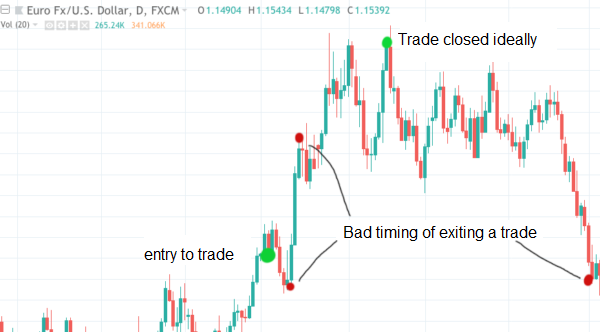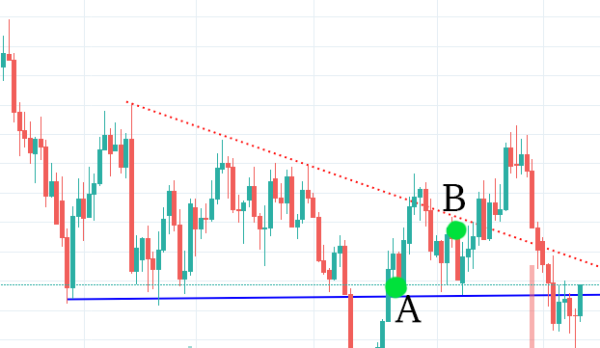
Does it mean that’s it? The position was opened and we’re good? No, it doesn’t; it’s not even half of it. Let’s explore the most critical part of trading – closing a position.
Trading strategy
The trading strategy is the heart of trading. It’s nearly unthinkable to go to a forex market or another market without having a strategy. It’s not necessary to develop a sophisticated strategy in the form of a large manual; all you need is to put on paper (important is “on paper” not “in mind”) a few notes such as the type of instrument you want to trade, the timeframe, the volume and conditions for entering a position. Most traders have such a trading strategy. Sometimes they spend tens of hours on developing it. But what about exit or exit conditions? Should they be included, too? Yes, they should. They are more important than the entry (conditions). Why? I’ll explain it in the following text.
Closing position
Before making a trade, it is necessary to know that you want to close it when in profit (take profit) or when in loss (stop loss). These must be indicated in your trading strategy and be backtested (tested on historical data). How else would you know that your trading strategy is profitable?
About seven years ago, as a beginner, I made the same experience as described. I can reassure you that there are only a few exceptions. After hours of waiting you enter a position seemingly perfect which makes you think: “This is an ideal position for me. Now, I’m going to make a fortune. Eventually, this is a reward I deserve for all the waiting”. But later on you realize that your profit margin is nothing to write home about. You are in most most of the time, sometimes in profit but the margin is negligible.
After being in this position for some time, you feel nervous and think that this is odd. Eventually, after a long streak of losses you find yourself in profit. You don’t hesitate and hastily exit.”
The above behavior is typical. So what’s happening? Most times it’s nothing unusual. The market has slowed down making the trader nervous. For fear of suffering loss, the trader exits with a laughable profit in his pocket. After retroactively analyzing the trade, you realize that if you had been patient you would have earned the full profit. The implications of making such a mistake (even if the number of mistakes is “just” two out of ten trades) are not fatal but they more or less differentiate a successful from an unsuccessful trader.
The whole issue is not about two concrete trades. Two less profitable deals will not make you go bust. You must take into account a broader picture. You will miss the unearned profit when you need it to compensate your losses (already anticipated in your trading strategy).
For more details compare the risk-reward ratio of early closed trades. (More about RRR here)

There is a visible difference between a trade closed ideally and wrongly. Sometimes you must accept that not all trades will be closed ideally.
Closing position outside trading strategy
Trading generates stress and not all traders make always the right decision when opening a position. Think twice before you go ahead. Draw all the important elements in your plan. They will help you eliminate emotions.
Time to exit an open position before reaching take profit a stop loss levels
If you are trading the EUR/USD pair and suddenly hear in the news that FED or ECB is under investigation due to their involvement in some dirty deal to consider leaving a trade seems to be a wise move. The news will surely create nervousness across the markets and the volatility will increase, which is something you didn’t anticipate in your forecast.
Another type of a situation in which leaving a trade should be considered is ignoring. It may happen that you enter a trade based on misinterpreting some data or failing to see (ignoring) some important indication. (By the way, a fully concentrated trader should avoid such mistakes). So, exit seems to be the only viable option.
After entering a trade in line with your trading strategy, you suddenly notice that an important support or resistance level is approaching. If the level plays against you-you should at least carefully watch the progress of the trade. If a bounce follows it makes no sense to wait any longer. Of course, it’s all up to you.

Early closing of a trade
For illustration: A trader in the above picture entered the trade in point A based on a bounce resulting from a false breaking of support (blue) line. A few candlesticks later the trader spots a clear downward trend (red dotted line) and, before suffering loss, decides to close the trade, just in case.
If you spot other relevant indications or signals draw them in your trading strategy. Our description here is fairly large but your trading strategy may be pretty short. This specific section may include a few points only:
Criteria for closing a trade early:
- New / unexpected news about fraud, terrorist attack, unexpected interventions etc.
- Ignoring a message/fact
- Spotting a new important formation or support/resistance level
Closing a position within the trading plan
There is one more situation that occurs to me. You absolutely forget to include the criterion of “closing a trade” in your trading plan. This time, it depends on your trading strategy. Either, you can set your take profit and stop loss at fixed 20 pips. Trend lines may help you in better orientation, as well. Highs a low from a trade formation used for entering the trade can also be useful. By the way, you don’t have to rely on yourself only. You can use our articles as inspiration or help in the development of your trading strategy. Advanced traders may reflect their knowledge or add some new elements to their strategies.
The trading strategy is the core, heart, fundament… of trading; you’ve heard that many times. A well-elaborated trading strategy with all the scenarios to which you stick can greatly help you become a successful trader. Remember, the exit is the most critical part which will decide on your success or failure. Poor timing of exiting a trade may affect your profit (too early exit resulting in low profit) or loss (too long keeping a position resulting in losing profit).



